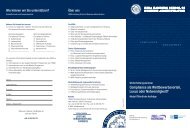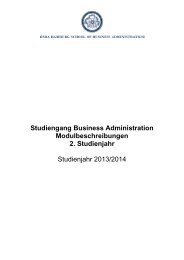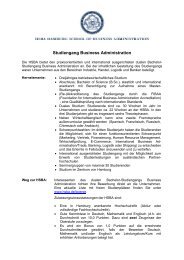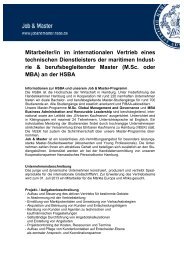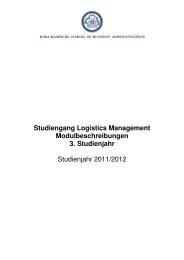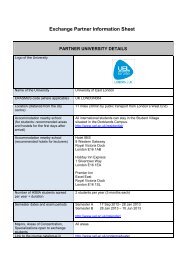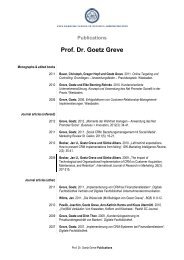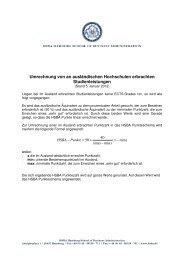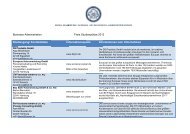Studiengang Business Administration, 2. Studienjahr - HSBA
Studiengang Business Administration, 2. Studienjahr - HSBA
Studiengang Business Administration, 2. Studienjahr - HSBA
Erfolgreiche ePaper selbst erstellen
Machen Sie aus Ihren PDF Publikationen ein blätterbares Flipbook mit unserer einzigartigen Google optimierten e-Paper Software.
3.6. Recent developments in the structural features of organizations (virtual and network<br />
organization structure)<br />
4. Process and Work Design<br />
4.1. Process organization<br />
4.<strong>2.</strong> Alternative job design approaches<br />
5. Management Concepts<br />
5.1. <strong>Business</strong> reengineering<br />
5.<strong>2.</strong> Lean management/production<br />
5.3. Quality management<br />
5.4. Knowledge management<br />
6. Managing Organizational Change<br />
6.1. Models for individual change<br />
6.<strong>2.</strong> Models for organizational Change (Lewin, Kotter)<br />
6.3. Mobilizing employees to change<br />
Teaching and learning methods<br />
The course combines conceptual and experimental approaches. It involves exercises, case<br />
studies, lectures, presentations and group work. Active participation in discussions is expected.<br />
Special features<br />
Demands on company training<br />
To get a solid understanding of organizational structure und organizational development,<br />
corporate training shall complement and flank the academic course of study by giving the<br />
students an opportunity to (numbers refer to lecture agenda/contents):<br />
» Get to know organization charts, job descriptions, and work flow diagrams (<strong>2.</strong>5)<br />
» Learn about different approaches in structuring jobs and departments and their respective<br />
advantages and disadvantages (<strong>2.</strong>1, <strong>2.</strong>2, <strong>2.</strong>3)<br />
» Assess reasons for different spans of control and hierarchical structures (<strong>2.</strong>2)<br />
» Know and be able to evaluate coordination mechanisms such as hierarchy and internal<br />
market (<strong>2.</strong>4)<br />
» Explain the current organization structure of the company and its historical development<br />
(3.1, 3.2, 3.3)<br />
» Learn about process-oriented structural design (4.1)<br />
» Evaluate the organizational and operational tasks in the company and develop ideas for<br />
its optimization (4.2, 5.1)<br />
» Know about current approaches to mobilize employees to change and how to navigate<br />
the change journey (6.2, 6.1)<br />
» Gain experiences in (change management) projects (6.3)<br />
Recommended literature<br />
» Daft, R L. (2010), Organisation Theory and Design, Cincinati: Thomson<br />
» Cameron, E. & Green, M. (2008), Making Sense of Change Management, London:<br />
Kogan-Page<br />
» Robbins, S.P. & Judge, T.A. (2008), Organizational Behavior, Prentice Hall International<br />
Additional Reading:<br />
» Burnes, B. (2004), Managing Change: a strategic approach to organizational dynamics,<br />
Prentice Hall<br />
» Burton, Richard M. (2006), Organisational Design: A Step-by-Step Approach<br />
» Kates, Amy (2007), Designing your Organization: Using the STAR Model to solve 5 critical<br />
Design Challenges<br />
© <strong>HSBA</strong> HAMBURG SCHOOL OF BUSINESS ADMINISTRATION 2



